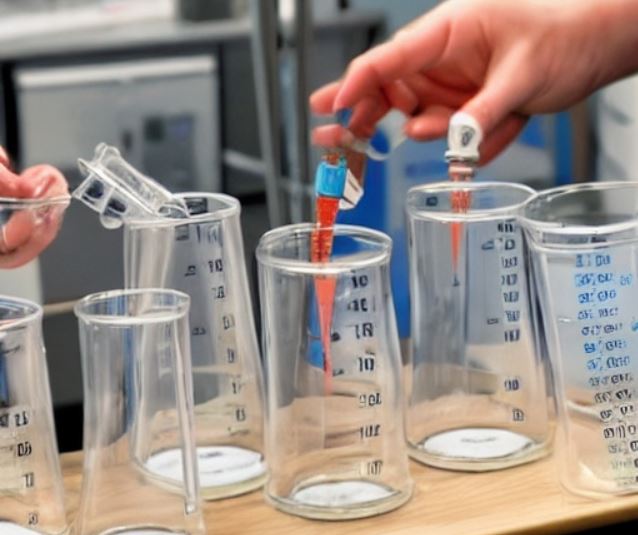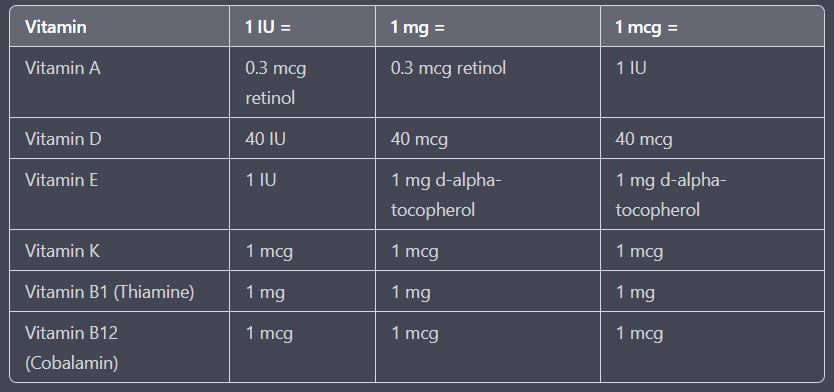MG and IU are units of measurement for mass (milligrams) and International Units respectively. Milligrams (mg) are used to measure the mass of a substance, typically in the context of medication or supplements.
International Units (IU) is a unit of measurement for biological activity, specifically vitamins, and hormones. The conversion factor between mg and IU depends on the specific substance being measured. For example, 1 IU of Vitamin E is equivalent to 0.67 mg of d-alpha-tocopherol.

What is an International unit?
International Unit (IU) is a unit of measurement for the amount of a substance, such as a vitamin or a hormone, present in a medication or dietary supplement. The definition of an IU varies depending on the substance being measured, but it is often based on biological activity or potency. It is important to note that IU is not a standardized unit and should not be used for the accurate comparison of different substances or products.
What is Milligram?
Milligrams (mg) are used to measure mass or weight. A milligram is equal to 1-thousandth of a gram.
What is the difference between mg and IU?
“IU” (International Units) and mg (milligrams) are different units of measurement that are used in different contexts: for example, IU is used to measure the biological activity of substances such as vitamins, hormones, and enzymes. It reflects the potency or effectiveness of a substance in producing a biological effect.
“mg” is used to measure the mass or quantity of a substance, typically in the context of medication or supplements.
It’s important to note that the conversion factor between IU and mg for a specific substance can vary, and therefore, it’s not always possible to directly compare these units. Always check the specific conversion factor for the substance you are interested in.
For Example, 1 IU of Vitamin C is 50 mgs, but 1 IU of insulin is 0.045 milligrams. That’s for the pure crystalline versions of those chemicals: a different preparation or a related chemical may have the same effect using a different amount, and that would also be 1 IU.
International units are used to quantify vitamins, hormones, medicines, vaccines, blood products, and similar biologically active substances.
Related: What and How Calculate % v/v, % w/w and % w/v
Convert Between IU, MG and MCG
The conversion between IU, mg, and mcg depends on the specific substance being measured. To convert between these units, you need to know the conversion factor for that substance. Here’s a general formula for converting between these units:
To convert from IU to mg, you can use the following formula:
mg = IU x (mg/IU)
Where (mg/IU) is the specific conversion factor for the substance being measured.
To convert from mg to IU, you can use the following formula:
IU = mg / (mg/IU)
To convert from IU to mcg, you can use the following formula:
mcg = IU x (mg/IU) x 1000
To convert from mcg to IU, you can use the following formula:
IU = mcg / (mg/IU) x 1000
Conversion from Milligrams to Micrograms:
By definition 1,000 mcg = 1 mg. Multiply the number of mg by 1,000 to find the ug. For example, convert 2.56 mg to micrograms: 2.56 X 1,000 = 2,560 mcg.
Dividing the number of mg by 1,000 to find the number of mg. For example, convert 526 mcg to milligrams: 526 / 1,000 = 0.526 mg.
Calculate how many milligrams a given number of IUs corresponds to. Amounts (in milligrams) of a vitamin, dietary supplement, or medication that produce the same biological activity are represented by one IU. There is no set formula for this conversion because the amount varies for each vitamin, supplement, and medication, but the procedure is the same. Assume, for example, that 1 IU of vitamin E equals 0.671 mg of vitamin E. (d-alpha-tocopherol). Calculate how many milligrams there are in 150 IU of vitamin E. By dividing the number/quantity of IUs by the milligram equivalent of vitamin E, you may determine the milligrams of vitamin E: Vitamin E is equal to 100.65 mg (0.671 mg/IU x 150 IU).
Find the number/quantity of IUs that corresponds to a specified amount (mg) of a vitamin, dietary supplement, or medication. You need the same data as previously to perform any conversion because you are working with IUs yet again. Assume you are working with vitamin E yet again, but this time you need to determine how many IUs are equivalent to 335.5 mg of vitamin E. The following equation can be solved by substituting the known data: 335.5 mg / 0.671 mg/IU = 500 IU.
International Units
International units, in a contrast to milligrams and micrograms, reflect the level of biological activity of a drug. The biological impact of a certain substance on the body is measured in terms of one international unit, or IU.
The IU value for particular vitamin formulations was established through an international agreement among numerous scientific organizations.
Depending on how the vitamin was created, each sort of vitamin preparation has a different IU value.

Frequently Asked Questions (FAQs):
What is the difference between mg and IU?
Milligrams (mg) are metric units of mass/weight, used to measure the quantity of a substance. International Units (IU) is a unit of measurement used to express the potency or biological activity of substances such as vit., hormones, and enzymes.
Is 1 mg equal to 1 IU?
No, 1 mg is not equal to 1 IU, the conversion factor between mg and IU can vary depending on the materials being measured. For example, 1 IU of vitamin E is equal to about 0.67 mg, while 1 IU of vitamin D is equal to 0.025 mg.
Can I use mg and IU interchangeably?
No, you cannot use mg and IU interchangeably because the conversion factor between the two units can vary from material to material.
What is a safe dose of a substance in IU?
The safe dose of a substance in IU can vary depending on factors such as age, weight, and health status of patients. It is important to consult with a pharmacist/doctor or follow the recommended daily allowances established by regulatory agencies such as the FDA or the European Food Safety Authority (EFSA).
Why are some substances measured in IU and others in mg?
The choice of the unit depends on the nature of the substance being measured. IU is commonly used for substances that have biological activity, while mg is used for substances with a mass.
Can I convert IU to mg and vice versa?
Yes, it is possible to convert IU to mg, but you need to know the conversion factors of that particular substance being measured. The conversion factor can vary depending on the substance and is usually provided by the manufacturer or listed in regulatory documents.
Are IU and mg used internationally?
Milligrams (mg) are used internationally as a metric unit of mass, but International Units (IU) may not be recognized or used consistently in different countries. It is always important to check the unit used for a substance and understand its meaning before using or comparing products.
What are some common substances measured in IU?
Some common substances measured in International Units (IU) include vitamins A, D, E, and K, insulin, and some hormones.
Are there any health risks associated with taking too much of a substance in IU or mg?
Yes, taking excessive amounts of certain substances can lead to health problems and adverse effects. so it becomes necessary to consult with your doctor/pharmacist before their consumption.
